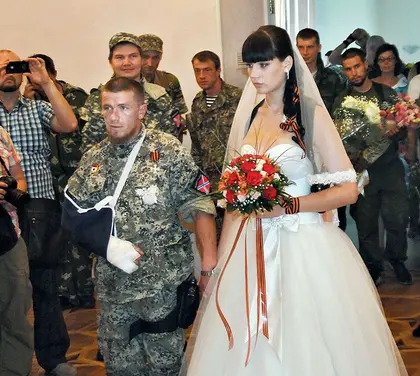He lent credence to the charges by admitting to killing 15 prisoners in a recorded interview by phone with the Kyiv Post on April 3.
“I don’t give a f*** about what I am accused of, believe it or not. I shot 15 prisoners dead. I don’t give a f***. No comment. I kill if I want to. I don’t if I don’t,” he said.
JOIN US ON TELEGRAM
Follow our coverage of the war on the @Kyivpost_official.
Behind the acts of violence is the world view of a Russian imperialist who gained military experience during the Second Chechen War in Russia.
- Look at the latest Ukraine news that was released today.
- Receive the latest Ukraine news bulletins for today.
He believes Russia is fully justified in attacking Ukraine.
Italian photographer Cosimo Attanasio, who was briefly detained by Motorola’s Sparta Battalion in February and taken to its premises in Donetsk, told the Kyiv Post that the building resembled a scene from Mad Max, an Australian cult film featuring a post-apocalyptic anarchist society without law and order.
“At the entrance, there are a lot of vehicles, including tanks and trucks,” Attanasio said. “There is a big truck with handmade armor reinforcements, all painted in spray, and inscriptions written in very shocking colors. It looks like Mad Max. One inscription (on a truck) read MOTOROLA in big letters in red.”

Attanasio was held by Motorola’s men for about three hours and says all Sparta Battalion fighters whom he saw at the building were under the age of 25, except for one.
Motorola, 32, was born in the Komi Republic and also reportedly used to live in Rostov-on-Don. Previously he had a blue-collar job and worked as a lifeguard.
He believes that Ukraine is committing genocide against its own people.
“In Chechnya there was a normal anti-terrorist operation: Arab, Chechen and European mercenaries were destroyed. Just mercenaries,” Motorola told Russian newspaper Zavtra in June 2014. “The local population didn’t suffer. Here it’s a totally different situation. It’s a real genocide.”
During the two Chechen wars, Grozny, the capital of Chechnya, was almost razed to the ground, with the United Nations calling it “the most destroyed city on Earth.” Human rights defense group Amnesty International estimated in 2007 that up to 25,000 civilians had been killed in the Second Chechen War and up to 5,000 had disappeared.
Amnesty and other human rights groups have also reported on indiscriminate shelling of civilian areas by Russian troops, hundreds of extrajudicial executions of civilians and prisoners of war and so-called “filtration camps” comparable to Soviet and Nazi concentration camps. In one prominent case, Chechen human rights activist Zura Bitiyeva was summarily executed by a death squad in 2003, and the European Court of Human Rights later found the Russian government guilty of torturing her.
Motorola’s experience in Chechnya came in handy when Russia launched its aggression against Ukraine by seizing administrative buildings in Crimea in February 2014.
“I took a train and came here, I didn’t go into the details,” Motorola told Zavtra, commenting on his decision to come to Ukraine. “There are Russians here, that’s why I came. I’ve already said that, when Molotov cocktails started being thrown at the police on Maidan (during the 2013-14 EuroMaidan Revolution that ousted President Viktor Yanukovych), it became clear to me that it’s a war. After the Nazis said that they would kill 10 Russians for every one of their kind killed, it didn’t make sense to wait until the threat became reality.”
The mercenary’s claim to be a defender of Russian interests is at odds with the eastern Donbas being a majority Ukrainian region. It is also at odds with the view of many ethnic Russians who support Ukraine.
He wears medals given by Russian President Vladimir Putin for the “return and protection of the (Crimean) peninsula,” according to footage broadcast by Russian television channel Rossiya-1.
The Kremlin has described the annexation as driven by locals but numerous Russian citizens became members of Crimea’s “self-defense units,” and Russian regular troops also took part.
The next step in Motorola’s career was Russian-backed unrest in Kharkiv – something that was portrayed by Kremlin propaganda as a grassroots uprising by locals but also turned out to be coordinated by Russians.
Motorola said in a YouTube video published in March that he took part in clashes between pro-Russian and pro-Ukrainian activists on March 14, 2014 in Kharkiv. Meanwhile, a YouTube video shows Motorola attending a pro-Russian rally in Kharkiv on March 16, 2014.
In April 2014, the Russian militant proceeded to fight in Donetsk Oblast’s Sloviansk after it was seized by Igor Strelkov, another Russian citizen and ex-officer of Russia’s Federal Security Service, the successor to the Soviet KGB.
Following the withdrawal of Russians and their proxies from Sloviansk in July, Motorola was appointed by Kremlin-backed forces as the “people’s mayor” of Donetsk.
His next mission was Illovaisk in Donetsk Oblast, where hundreds of Ukrainian troops were massacred after Russian regular troops invaded Ukraine in August.
Motorola’s ascendance continued at Donetsk Airport, where his Sparta Battalion played a major role in fighting since September 2014 and in taking over what was left of the hollowed airport in January 2015.
The militant’s family life is controversial, since he has been accused of bigamy.
In June 2014 he said he had a wife and a 5-year-old son in Russia. This did not prevent him from marrying a resident of Sloviansk in July, though there is no evidence that he got divorced with the first wife.
Kyiv Post staff writer Oleg Sukhov can be reached at reaganx84@gmail.com.
You can also highlight the text and press Ctrl + Enter




